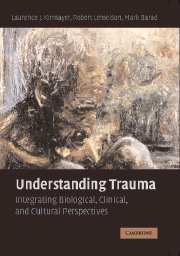Book contents
- Frontmatter
- Contents
- List of Figures
- List of Tables
- List of Contributors
- Foreword by Robert Jay Lifton
- Preface
- List of Abbreviations
- Introduction: Inscribing Trauma in Culture, Brain, and Body
- SECTION I NEUROBIOLOGICAL PERSPECTIVES ON TRAUMA
- 1 Neurobiological and Neuroethological Perspectives on Fear and Anxiety
- 2 Some Biobehavioral Insights into Persistent Effects of Emotional Trauma
- 3 Learning Not to Fear: A Neural Systems Approach
- 4 Mechanisms of Fear Extinction: Toward Improved Treatment for Anxiety
- 5 Developmental Origins of Neurobiological Vulnerability for PTSD
- 6 Does Stress Damage the Brain?
- 7 Somatic Manifestations of Traumatic Stress
- SECTION II CLINICAL PERSPECTIVES ON TRAUMA
- SECTION III CULTURAL PERSPECTIVES ON TRAUMA
- Epilogue: Trauma and the Vicissitudes of Interdisciplinary Integration
- Glossary
- Index
- References
3 - Learning Not to Fear: A Neural Systems Approach
Published online by Cambridge University Press: 27 July 2009
- Frontmatter
- Contents
- List of Figures
- List of Tables
- List of Contributors
- Foreword by Robert Jay Lifton
- Preface
- List of Abbreviations
- Introduction: Inscribing Trauma in Culture, Brain, and Body
- SECTION I NEUROBIOLOGICAL PERSPECTIVES ON TRAUMA
- 1 Neurobiological and Neuroethological Perspectives on Fear and Anxiety
- 2 Some Biobehavioral Insights into Persistent Effects of Emotional Trauma
- 3 Learning Not to Fear: A Neural Systems Approach
- 4 Mechanisms of Fear Extinction: Toward Improved Treatment for Anxiety
- 5 Developmental Origins of Neurobiological Vulnerability for PTSD
- 6 Does Stress Damage the Brain?
- 7 Somatic Manifestations of Traumatic Stress
- SECTION II CLINICAL PERSPECTIVES ON TRAUMA
- SECTION III CULTURAL PERSPECTIVES ON TRAUMA
- Epilogue: Trauma and the Vicissitudes of Interdisciplinary Integration
- Glossary
- Index
- References
Summary
Most people who experience trauma do not develop posttraumatic stress disorder (PTSD). While 75% of adults have had a traumatic experience fulfilling current DSM–IV criteria as potential factors in the development of PTSD, only 12% actually developed PTSD (Breslau & Kessler, 2001). This suggests that the majority of persons are highly resilient in the face of trauma (Charney, 2004). What are the neural mechanisms that allow a person to recover from trauma without enduring effects? Recent work has focused on extinction of classically conditioned fear as a useful animal model of recovery after trauma. In cued fear conditioning, a tone is paired with a mild footshock. After several such pairings, rats learn that the tone predicts the shock and exhibit a range of species-specific fear responses, including freezing and potentiated startle responses (see Rau & Fanselow, this volume). In extinction, the conditioned tone is repeatedly presented without the shock, causing rats to learn that the tone is no longer dangerous. Understanding the neural mechanisms of extinction learning could lead to new treatments for PTSD, given that extinction underlies exposure-based therapies used to treat PTSD (Foa, 2000; Rothbaum & Schwartz, 2002).
EXTINCTION OF FEAR IS NEW LEARNING
While it may be tempting to think that extinction of conditioned fear simply erases the original tone–shock association, substantial behavioral evidence suggests that this is not the case.
Information
- Type
- Chapter
- Information
- Understanding TraumaIntegrating Biological, Clinical, and Cultural Perspectives, pp. 60 - 77Publisher: Cambridge University PressPrint publication year: 2007
References
Accessibility standard: Unknown
Why this information is here
This section outlines the accessibility features of this content - including support for screen readers, full keyboard navigation and high-contrast display options. This may not be relevant for you.Accessibility Information
- 2
- Cited by
